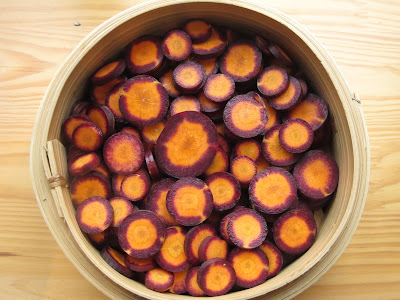 |
| "Peaces" of carrot |
I love kitchen gadgets. I can spend hours inside a
kitchen store. I can’t have enough of serving bowls, of all sizes. When I travel,
I like bringing back a serving bowl that will remind me of the place I visited
and add an exotic touch to my dinner parties.
Three weeks ago, my friends Tania and Roy came to
see us with their kids. Tania brought as a gift from Israel a beautiful serving
bowl with a recipe for a carrot salad written on the bottom. I asked her to
translate the recipe for me - I was
looking forward to make it the next day.
In one of my recent visits to Planet Organic I bought
the Faitrade Zaytoun Palestinian olive oil. So, I had a chance to bring together the flavours of the
two countries and promote peace in my kitchen.
There was no disagreement for Dean, Nina and I:
the carrot salad was a winner.
Thanks T!
Thanks T!
 |
| My lovely gift |
 |
| The ingredients |
 |
| Steam the carrots until tender |
 |
| marinate the onion and garlic |
 |
| My delicious spicy carrot and onion salad |
Carrot peace salad
Serves 4
An easy recipe packed with good
nutrients. The smoked and spicy paprika adds a special flavour. This salad
contains a great amount of vitamin C.
INGREDIENTS
5 organic seasonal carrots
1
small red onion
1
garlic, crushed
30ml
of extra-virgin olive oil
Juice
of 1 lime or lemon
A
handful of coriander
½
tsp smoked Spanish paprika, hot
Sea
salt and black pepper to season
METHOD
Slice the red onion and marinate with lime juice, olive oil, crushed garlic and paprika.
Simmer
the carrots until tender. Let it cool.
Place
the carrots into a bowl, add the marinated onion, the coriander and mix them
gently.
Season
and serve.
Some of the
ingredients and their health benefits
Carrot (Daucus carota): is high in carotenoid,
an antioxidant compound associated with many healthy benefits. They contain lutein and zeaxanthin (carotenoids present in our retina),
which is why carrots are famously known for being good for your eyes. The
carotenoids and vitamin A contents found in carrots are fat-soluble vitamins -
when eaten with a little fat (olive oil, coconut oil, ghee etc) they are better
absorbed by your body. They also provide good levels of vitamin K, fibre,
vitamin C, biotin, vitamins B1 and B6.
Paprika
(Capsicum annuum):
is a type of ground
pepper that is in the same family as chili and bell peppers. Paprika is
extremely high in vitamin C, which increases the absorption of iron-rich foods.
Paprika contains plant enzymes that can neutralize acidity in the stomach,
aiding digestion. The peppers used to make paprika contain high levels of the
phytochemical capsaicin, which is known for its antioxidant properties. Capsaicin also has
anti-inflammatory properties, which can alleviate arthritis and joint pain, and
can improve blood circulation.
Onion (Allium cepa): belongs to the allium family (leeks, garlic and
shallots). It contains powerful antioxidants and has antiviral
properties. It’s also anti-inflammatory, and contains the compound quercetin which supports the immune system and
acts as an anti-allergenic. People who suffer from hay fever are often
recommended a therapeutic supplement of quercetin - that
may help to alleviate their symptoms. Research has shown that onions help build
strong bones and keep serum cholesterol and blood pressure low, preventing
heart disease.
Till
next week!































